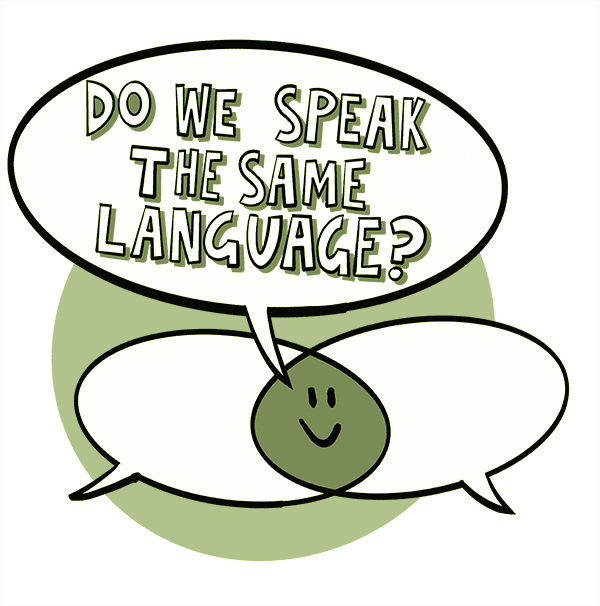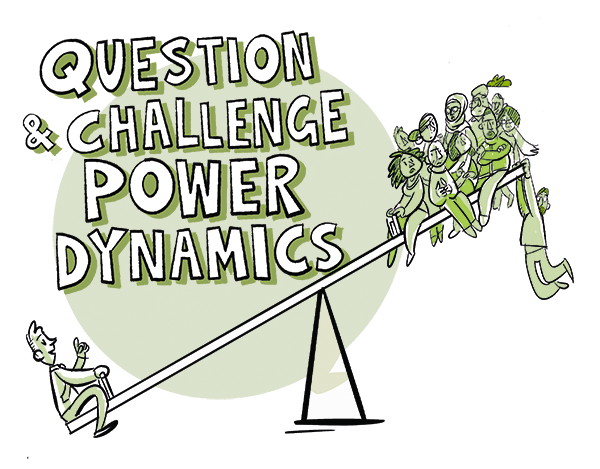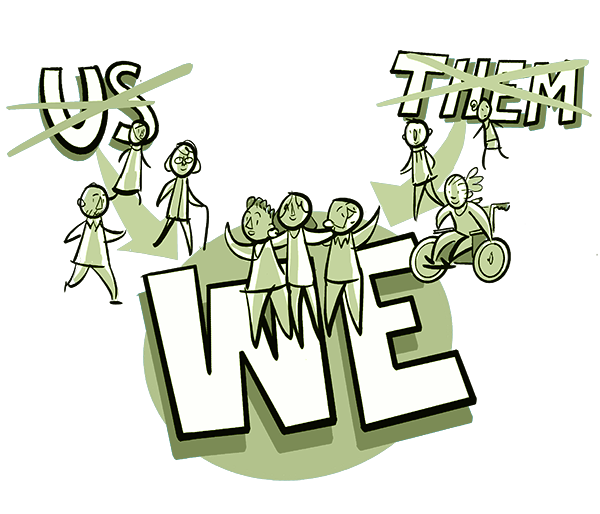Challenge power dynamics

Challenge power dynamics
It is easy to underestimate, or not be aware of, the implicit power that comes from being an ‘institution’, both as a venue/space, a nationally known organisation or as a part of the science sector. A science centre, museum, university, or learned society can be perceived externally as being powerful and intimidating.
As your partnership grows, try to keep unpicking any assumptions about priorities, perceptions and motivations that either party may have made about the other partner. Otherwise, this will continue to impact on how partners feedback and interact.
You may find you need to talk about a shared language. Historical terms commonly used in informal science learning (such as ‘disadvantaged’ or ‘deprivation’) are often considered inappropriate.
Changes made in response to questions and challenges about power dynamics can be a useful thing to capture over the course of the relationship (see section on Evaluation in Practice) so prioritise putting time aside for shared reflective practice and regular communication. This can help challenge perceived power dynamics and support a healthy and effective partnership to flourish.
TOP TIP
Arrange for your initial scoping meeting to take place on neutral ground. This could be a coffee shop, library or café. Choosing to meet somewhere neutral removes this possibility of intimidation.
I can't really say that one group is leading the other one, we are just interacting together in a very good way, and we just try to make things happen in the best way possible... we have the experience of how we can run it in the best way in the community and they know how it's best to run it to make it more interesting for local children, so that's a nice combination.
Community Partner, Cambridge

Find each other’s superpowers
Each partner brings unique gifts to the partnership. Neither should relinquish all control, but partners should feel able to lead where their expertise lies. With trust and honesty, partnerships should feel able to feedback honestly to each other.
Always develop your partnership from an asset-based approach. Avoid the perception of any partner as being in deficit (‘lacking’ or ‘missing’ something). Always consider what you both bring, such as different approaches, ideas, spaces, networks, skills and expertise.
Case Study from Explore Your Universe
Partnerships were supported when science centres could meet community partners’ needs in other tangible ways. During EYU4 engagements, Techniquest were able to offer their science centre space to a community partner who did not have the necessary space available to them. This was a great example of being responsive and adaptable, going beyond the goals of the project to develop a true partnership.
What your partner might bring:
Your community partner may bring trusted relationships with individuals, cultural and linguistic expertise, safeguarding training, co-design and evaluation. Working with a partner will bring renewed energy, enthusiasm and expertise in areas different from your own, and add valuable breadth of perspective to your organisation.
What you might bring:
Informal Science Learning organisations can bring a lot to the partnership beyond science resources and expertise. This could be providing a venue, wider learning resources, advocacy and dissemination, or the opportunity for youth work experience and developing employability skills.
All partners have resources and assets, and an effective partnership creates a resource pool that every partner can draw on. Museums have successfully partnered with libraries, schools, churches and other cultural institutions, to cooperate and share resources and spaces rather than compete.
P. Bienkowski and H. McGowan, Managing Change in Museums and Galleries

Equity in decision making
The way we position ourselves in a relationship will pre-determine how equitable and collaborative our partnership will be. When approaching a new partner organisation, be transparent. Share a copy of the project proposal, including the budget line, so that your partner understands the aims of the project and what support is available. Equally, when making important decisions, ensure that the community partner has the same number of representatives as you. This prevents you from dominating any discussions. Keep asking the question – at each decision-point – who has representation, who does not have a voice, who is not in the room who should be in the room?
Learning from the wider sector
Developed by the Youth Equity+STEM (YESTEM) project, The Equity Compass is a valuable resource to help you adopt a social justice mindset across multiple dimensions of equity (represented by eight segments of the compass). It is a reflective tool that is particularly useful when making decisions, designing and developing policy and programming. A free online Equity Compass course exists to help informal STEM learning, outreach and public engagement people create equitable, participatory STEM programmes. Find this course and more about the Equity compass at: yestem.org/tools/the-equity-compass/
Case Study from Explore Your Universe
To support transportation to the science centre, Dynamic Earth proposed organising a minibus to bring participants to their centre. However, their community partner advised against this. Instead, they wanted to encourage families to take public transport, since confidence to take the bus was a skill the community partner had identified as a learning need for their members.
In this example an assumption that a particular approach would be preferred could have been made and a meaningful opportunity missed. This highlights that community partners need to be involved in these discussions and lead the decisions that impact their group.
Equity in funding
When sharing the proposal be sure to be transparent and open about the project budget. Withholding information or being unclear shows that you place yourself in a higher position of authority. Funding can cause an uncomfortable power imbalance, so keep challenging yourself and your organisation. A crucial step towards equitable working is to ensure staff costs across all partnering organisations (including volunteers) are valued in the budget. Best practice would be to prepare the funding proposal together. This ensures a more equitable and co-produced delivery, evaluation and budget plan from the very start.
However, it is important to acknowledge that there is a risk to beginning these conversations with new community partners based on a grant application that may not be successful, so be cautious on the depth of your scoping interactions if this is at a cost to your community partner.
Usually a single organisation holds the funding and is the main party leading the application, the budget, and is required to submit the evaluation. They often ultimately decide the scope of the programme and what success looks like unless the funder specifically encourages more active involvement.
The administrative pressure might feel appropriate to be shouldered by the bigger organisation that might be better placed (e.g. having dedicated finance personnel and audited accounts) to help process this. However, in some experiences, this opportunity to hold the funds – if desired by the community group – can help develop a longer-term capacity to hold funding in the future and become more self-sustainable.
Learning from the wider sector
The Ideas Fund (theideasfund.org) run by the British Science Association and the Community Research Network funding, delivered by UKRI (building on research from the Young Foundation), are two initiatives that provide funding to communities to drive their own ideas, partnerships and research and innovation.
Case Study from Explore Your Universe
The Association for Science and Discovery Centres asked for evidence of conversation and consultation between partners at the proposal stage which ranged from co-written proposal submissions to letters of support from partners.
A greater depth of co-production, and more commitment from partners to the project, correlated with the perceived degree to which the proposal and decisions on budget allocation had included both partners.
It is important to be aware that funding doesn't solve everything, for example those who might have caring responsibilities, rural communities, small organisations often overwhelmed to deliver services, or community members who aren't doing this as their main jobs. For many, time can't simply just be 'bought out'.
Lewis Hou, Science Ceilidh
At a mid-point during Explore Your Universe Phase 4, funding was allocated directly to community partners to support their ongoing engagement with STFC science. Learning from this explores the power dynamics around who holds funding, the different agendas and opportunities that can develop, and when/why it’s often not all about the money.
Where money is given directly to the community partners, science centres’ support around proposal development (e.g. what activities might be feasible and how they could be used) was very valuable. In addition community partners found science centres’ knowledge – such as ideas of where to source the supplies and which are high quality – was particularly useful to reduce administrative burdens.
As highlighted throughout this handbook, flexibility on behalf of the science centres was key. As organisations and as a network, their systems and processes could be responsive and nimble to adapt to changing priorities or needs.
The more informal science learning and education organisations are able to serve the provisions, priorities and ambition of their community partners, the more they become genuine community assets.
Case Study from Explore Your Universe
Edinburgh Young Carers received direct funding from Explore Your Universe to develop STEM care packages. Edinburgh Young Carers took more ownership and leadership within the project, including the administrative burden, with Dynamic Earth now becoming more of a consultant partner. The STEM care packages were a fundamental part of their operations and further strengthened the partnership as they dealt with Covid-19 lockdown.
Learning from the wider sector
After an initial pilot with Science Ceilidh, People Know How started running their own science clubs with young people. The youth workers weren’t science specialists but had gained confidence from working with Science Ceilidh to have the key message “you don’t need to be a scientist to explore science, you don’t need to have all the answers, you just need to be curious and explore this together.”
Case Study from Explore Your Universe
Y Fenter / The Venture in Wrexham received direct funding from Explore Your Universe to facilitate a series of sessions called “Eich Gofod | Your Space”. This programme fosters an awareness of the night-time environment at the adventure playground with an emphasis on the observable universe and is being run independently by the play workers through gaining new ideas and knowledge through their partnership with Xplore! Science Discovery Centre.
Links and downloads
- Working in Partnership (PDF, 2.7MB)
